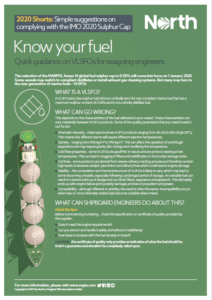In line with its guidance on how to be sulphur-compliant during a port state control inspection, the North Club issued another guidance assisting seagoing engineers on a safe and efficient switch towards very low sulphur fuel oil.
Given that IMO’s 2020 sulphur cap will come into force in about one month, except scrubbers and a variety of alternative, compliant fuel, vessels also have the option of switching towards the new generation of marine fuels – very low sulphur fuels (VSLFOs).
North highlights that
A VLSFO (very-low-sulphur fuel oil) is an umbrella term for any compliant marine fuel that has a maximum sulphur content of 0.50% and is not a wholly distillate fuel.
In light of the upcoming changes, seagoing engineers should be extra cautious when it comes to some quality parameters of VLSFO.
Specifically, a seagoing engineer should look out for:
- Kinematic viscosity – initial reports show VLSFO products ranging from 40 cSt to 300 cSt (at 50°C), meaning that different stems will require different injection temperatures.
- Density – ranging from 900 kg/m³ to 990 kg/m³. This may affect the operation of centrifugal separators and may require gravity disc change and modifying the temperature.
- Cold flow properties – some VLSFOs are paraffinic in nature and are prone to waxing at low temperatures, which may lead to clogging of filters and solidification in the bunker storage tanks.
- Cat fines – some products are derived from severe refinery cracking process and therefore contain high levels of abrasive catalytic (aluminium and silicon) fines which could lead to engine damage.
- Stability – the composition and chemical structure of VLSFOs is likely to vary, which may lead to some becoming unstable, especially following a prolonged period of storage. An unstable fuel can result in a severe build-up of sludge and can block filters, separators and pipework. This ultimately ends up with engine failure (and possibly damage) and loss of propulsion and power.
- Compatibility – although different to stability, the result is often the same. Incompatibility occurs when two or more otherwise stable fuels become unstable when mixed.
To prevent all the challenges expressed above, shipboard engineers can:
#1 Check the spec
Before commencing bunkering – check the specification or certificate of quality provided by the supplier.
#2 Avoid Mixing
Avoiding mixing of fuels is the most ideal option; Yet, if this can not be achieved, limit any mixing in the bunker storage tanks to a 90/10 ratio.
#3 Test the fuel on board
During bunkering, take periodic samples and test them for key quality parameters using onboard test kits that are common to most vessels.
#4 Test the fuel in a lab
Take a representative sample of the stem during bunkering using a drip sampler. Despatch it to a laboratory without delay. Typically test against ISO 8217 parameters.
#5 Keep evidence
In the event of a bunker quality dispute or if the vessel is subject to a port State control inspection, proper paperwork is key. Make sure the right documents are completed properly and are ready for inspection, such as bunker delivery notes (BDN), bunker checklists, specifications, letters of protest and any related correspondence.
To learn more on the guidance, click herebelow

































































What is the coefficient expasion of VLSFO?